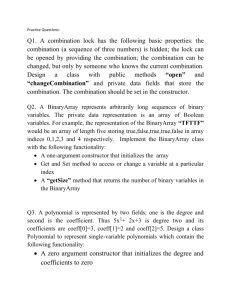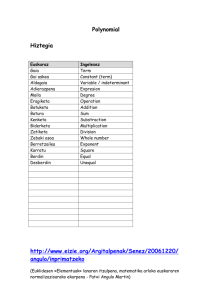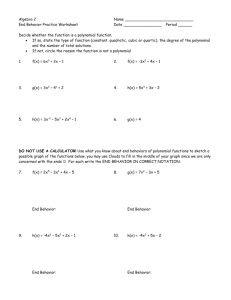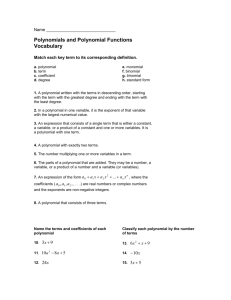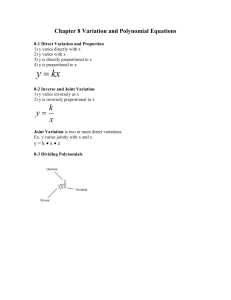A polynomial class using arrays
advertisement
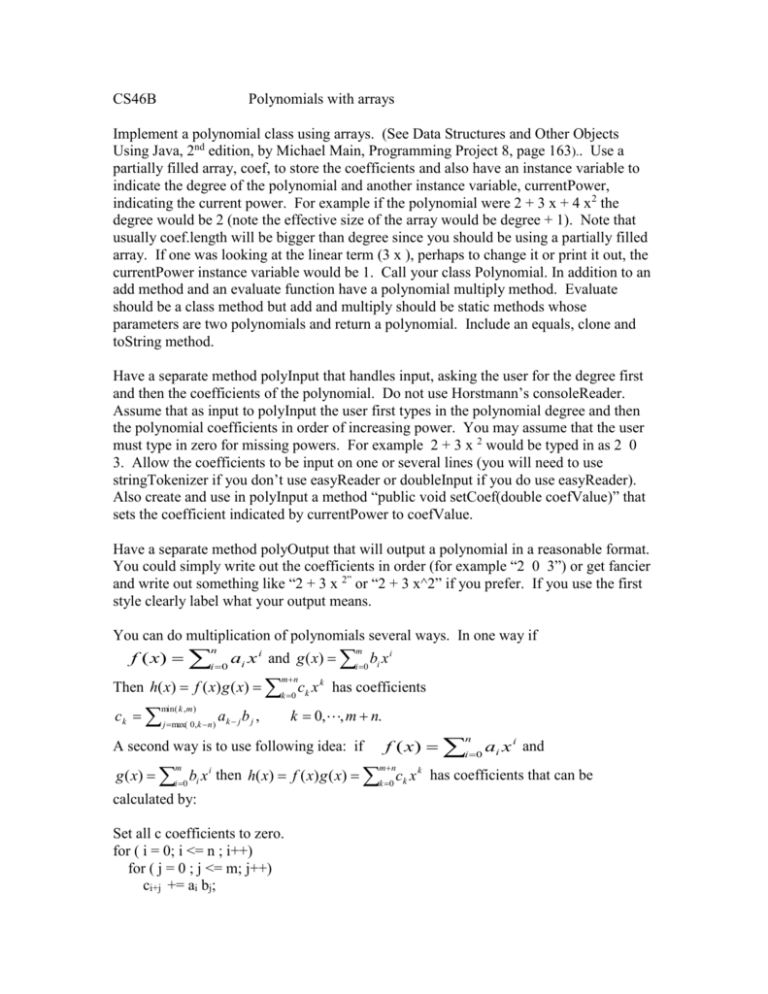
CS46B Polynomials with arrays Implement a polynomial class using arrays. (See Data Structures and Other Objects Using Java, 2nd edition, by Michael Main, Programming Project 8, page 163).. Use a partially filled array, coef, to store the coefficients and also have an instance variable to indicate the degree of the polynomial and another instance variable, currentPower, indicating the current power. For example if the polynomial were 2 + 3 x + 4 x2 the degree would be 2 (note the effective size of the array would be degree + 1). Note that usually coef.length will be bigger than degree since you should be using a partially filled array. If one was looking at the linear term (3 x ), perhaps to change it or print it out, the currentPower instance variable would be 1. Call your class Polynomial. In addition to an add method and an evaluate function have a polynomial multiply method. Evaluate should be a class method but add and multiply should be static methods whose parameters are two polynomials and return a polynomial. Include an equals, clone and toString method. Have a separate method polyInput that handles input, asking the user for the degree first and then the coefficients of the polynomial. Do not use Horstmann’s consoleReader. Assume that as input to polyInput the user first types in the polynomial degree and then the polynomial coefficients in order of increasing power. You may assume that the user must type in zero for missing powers. For example 2 + 3 x 2 would be typed in as 2 0 3. Allow the coefficients to be input on one or several lines (you will need to use stringTokenizer if you don’t use easyReader or doubleInput if you do use easyReader). Also create and use in polyInput a method “public void setCoef(double coefValue)” that sets the coefficient indicated by currentPower to coefValue. Have a separate method polyOutput that will output a polynomial in a reasonable format. You could simply write out the coefficients in order (for example “2 0 3”) or get fancier and write out something like “2 + 3 x 2” or “2 + 3 x^2” if you prefer. If you use the first style clearly label what your output means. You can do multiplication of polynomials several ways. In one way if f ( x) n i 0 ai x i and g ( x) i 0 bi x i m Then h( x) f ( x) g ( x) k 0 ck x k has coefficients m n ck j max( 0,k n ) ak j b j , min( k , m ) k 0,, m n. A second way is to use following idea: if f ( x) n i 0 ai x i and g ( x) i 0 bi x i then h( x) f ( x) g ( x) k 0 ck x k has coefficients that can be m calculated by: Set all c coefficients to zero. for ( i = 0; i <= n ; i++) for ( j = 0 ; j <= m; j++) ci+j += ai bj; m n This second ways mimics one way to multiply two polynomials when doing the multiplication by hand. Include description of the invariant of the ADT in your code and use javadoc comments in the style suggested by Main. Otherwise use good style as described in the first program assignment. Set the initial capacity of your arrays initially to 2 (to force you to resize some of the arrays in the runs below). Create a class TestPolynomial with a main program that will do the following: Input the degree and coefficients of a polynomial f(x) Input the degree and coefficients of a polynomial g(x) Output the degree and coefficients of f(x) + g(x). Output the degree and coefficients of h(x) = f(x) * g(x). Output the value of h(3). Also let p(x) be a clone of f(x) and use an if statement involving equals to write out whether p(x) is the same as f(x) and whether p(x) is the same as g(x). Do the following runs a) f(x) = 1 + 4x + 5 x2, g(x) = 1 + 4x + 5 x2 b) f(x) = 3, g(x) = 1 + 4x + 5 x2 c) f(x) = 3 + 4 x – x2 + 2 x4, g(x) = 1 –3x2 – x3 d) f(x) = 8, g(x) = 4 Note the grader may try other runs so you should test them. Turn in a listing of your source code, output of all of the above runs, javadoc documentation for your Polynomial class and a disk with Polynomial.java, TestPolynomial.java, as well as EasyReader or FormatWriter, if you use them. Place all these in the same directory (so delete the package statements from EasyReader and FormatWriter). You may develop your program using any Java but test it with TextPad and Sun’s Java (jdk 1.3 or 1.4) before turning it in. The grader will be using these and will deduct points if your code does not run on his / her computer. Clip your disk to your output with a “black clip”.

